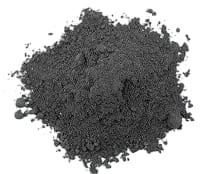Viewed products
-

Tin (II) Sulfide | SnS...
Tin (II) Sulfide (SnS) is a compound...
Semiconductor Materials
- Products
- Deposition Materials
- Refractory Metals
- Rare Earth Materials
- Powder
- Technical Ceramics
- Lanthanum Hexaboride (LaB6) Materials
- Pyrolytic Boron Nitride (PBN) Products
- Boron Nitride (BN) Products
- Alumina Ceramics (Al2O3)
- Aluminum Nitride (AlN) Products
- Silicon NItride (Si3N4) Ceramics
- Silicon Carbide (SiC) Ceramics
- Graphite Products
- Zirconia Ceramic
- MAX Phase Ceramic Materials
- Boron Carbide Ceramics (B4C)
- Magnesium Oxide Ceramics (MgO)
- Quartz Ceramics
- Macor Machinable Glass Ceramic
- Beryllium Oxide (BeO) Ceramics
- Piezoelectric Ceramics
- High Purity Materials
- Precious Metals
- Chemicals
- Crystals & Substrates
- Applications
- Other
 View larger
View larger Tin (II) Sulfide | SnS | CAS 1314-95-0
HTHP615
New product
Tin (II) Sulfide (SnS) is a compound semiconductor material of group II-VI layered structure. Heeger Materials can provide the best Tin (II) Sulfide (SnS) with a purity of 99.9% and 99.99% in the size of lump and powder at a competitive price. The size can be tailored according to specific requirements.
Please contact us if you need customized services. We will contact you with the price and availability in 24 hours.
Data sheet
| Symbol | SnS |
| Molecular Weight | 150.78 |
| Purity | 99.9% - 99.99% (3N-4N) |
| Size | lump/powder |
| Product | Tin (II) Sulfide |
| CAS | 1314-95-0 |
More info
Tin (II) Sulfide is a chemical compound of tin and sulfur. The chemical formula is SnS. Its natural occurrence concerns herzenbergite (α-SnS), a rare mineral. Heeger Materials offers a selection of over 100 high-purity products, including metals, metal oxides, and metal salts, with 99.999% purity or higher.

High-purity and ultra-high purity Tin (II) Sulfide (SnS) materials are crucial components for the research, development, and production of advanced technologies that require optimum properties, performance, and quality.
- Chemical formula: SnS
- Purity:99.9 %-99.99 %
- Molar mass:150.775 g/mol
- Density:5.22 g/cm3
- Melting point:882 °C (1,620 °F; 1,155 K)
- Boiling point: about 1230 ˚C
- Solubility in water: Insoluble
Related Products
- Tin (II) Sulfide (SnS) Granules
- Tin (II) Sulfide (SnS) Powder
- Tin (II) Sulfide (SnS) Sputtering Target
Applications
- Used as a candidate material for lithium-ion batteries, due to its high theoretical capacity and low toxicity.
- Used for solar cells due to its unique properties, such as a narrow optical bandgap and earth abundance.
- Used in power generation in vehicles, wearable devices, and industrial systems.
- Used as a catalyst in various reactions involving hydrogenation, desulfurization, and other chemical transformations.
- Used in gas sensing applications for environmental monitoring and safety management.
- Used as gas sensing applications for environmental monitoring and safety management.
- Used as lubricants and wear-resistant additives to improve the friction and wear properties of materials.
Packing:
Tin (II) Sulfide (SnS) is carefully packaged in carton boxes with foam protection to minimize damage during storage and transportation and to preserve the quality of our products in their original condition. The vacuum packing is 1kg/bag, 25kg/barrel, or based on specific requirements.
Inquiry to Heeger Materials
Items marked with an asterisk (*) are required.
Heeger Materials respects your privacy, and we will NOT sell or provide your personal data to other third parties, or allow them to use your personal data for their own purposes. However, we would like to send you information from time to time by mail or email about our products and special offers in addition to the interest categories you've selected above. Read our Privacy Policy
































